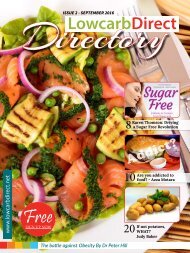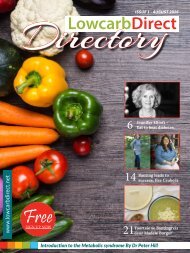LowCarbDirect.net Issue 03
LowCarbDirect.net Issue 03
LowCarbDirect.net Issue 03
Create successful ePaper yourself
Turn your PDF publications into a flip-book with our unique Google optimized e-Paper software.
18 | LowcarbDirect Directory - <strong>Issue</strong> 3 - October 2016<br />
A guide to healthy<br />
low-carb living<br />
by Dr Eric Westman<br />
The cornerstone behind the ADAPT<br />
program and nutritional products<br />
begins with the overwhelming science<br />
supporting the ADAPT Program. Dr Eric<br />
Westman, Associate Professor of Medicine<br />
at Duke University has written<br />
over 90 pier reviewed articles, written<br />
bestselling books and has treated over<br />
8 000 patients with Obesity, Diabetes,<br />
Metabolic Syndrome and other related<br />
conditions. He says:<br />
“The science is overwhelming,<br />
more and more evidence showing<br />
the benefits of a low sugar, low<br />
carbohydrate program continues<br />
to support our beliefs”.<br />
Dr Westman has spent the last 20<br />
years developing and refining the<br />
ADAPT program. The Nutritional<br />
product range is a direct result of this<br />
refinement and will continue to evolve.<br />
THE ADAPT PROGRAM<br />
What is Ketosis?<br />
The body uses what you eat for energy. On a typical American<br />
diet, when someone eats carbohydrates, the body burns glucose<br />
and carbohydrates for energy. If someone doesn’t eat carbohydrates,<br />
for example on a ketogenic diet, the body begins burning<br />
fat to produce energy, including its own body fat. This fat burning<br />
produces an organic compound called ketones in the blood<br />
– thus the name, ketosis. Because the body is using its own fat,<br />
a ketogenic diet results in rapid weight loss without significant<br />
hunger.<br />
Here are 7 tips for low-carb living that<br />
can help you lose weight…and keep<br />
the weight off!<br />
1<br />
Avoid Sugar and Starch<br />
Sugars and starches are also known as carbohydrates<br />
and can be measured in “grams.” Try to limit your carbohydrate<br />
intake to 20 grams a day by avoiding sugar, bread,<br />
fruit, flour, pasta or any other sugary/starchy food that has<br />
a lot of carbs. Read the labels!<br />
2<br />
Eat “Real Foods” That Have No Carbs<br />
When hungry, you can have as much as you want of<br />
meats (beef, pork, lamb, veal, sausage, hot dogs), poultry,<br />
fish and shellfish, and eggs. The amount of cream, oil, and<br />
butter is limited—be careful not to drink too much of these!<br />
3<br />
Eat Fat to Lose Fat<br />
Oils and butter have no carbs. You do not have to limit<br />
quantities, but you should stop eating when you’re full.<br />
Dr Eric Westman






